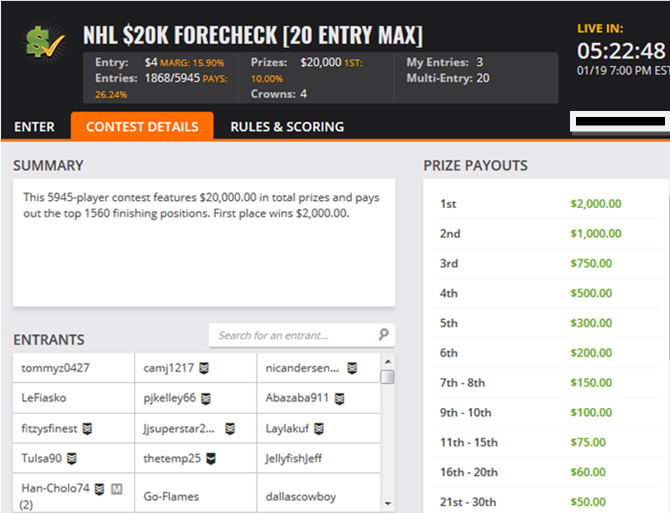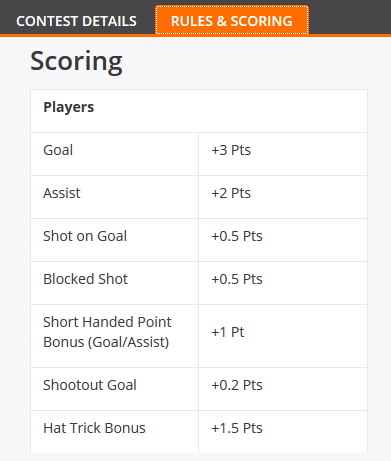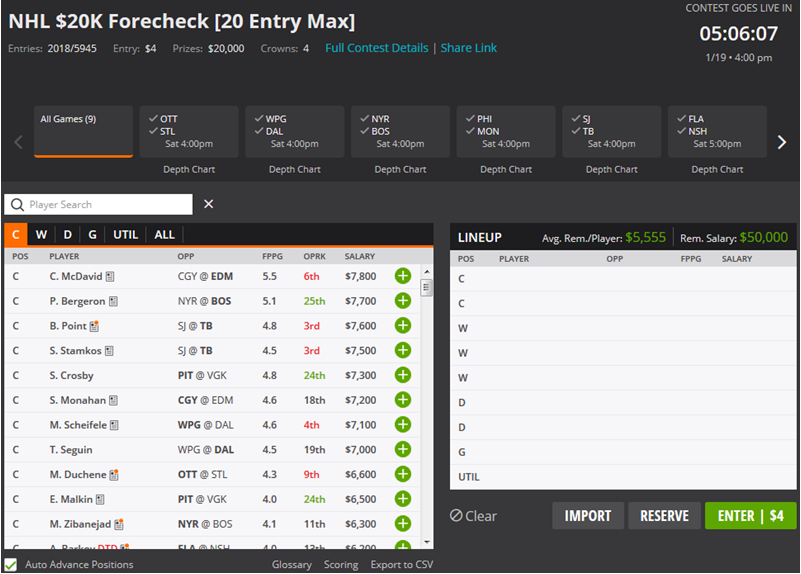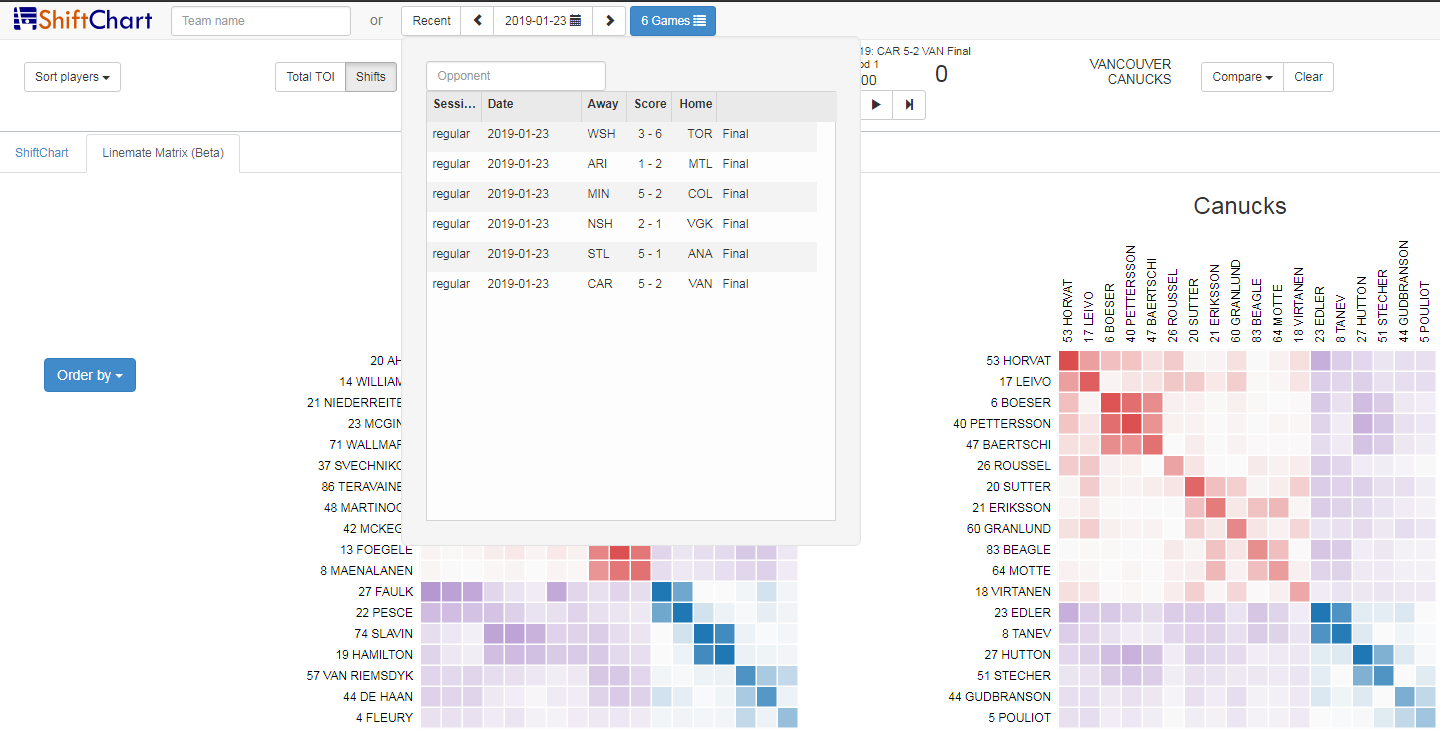NHL DFS: Process, Strategies, and Resources
Of the four major North American sports, the NHL is still lagging behind its competing leagues from a Daily Fantasy Sports perspective. NFL, MLB, and NBA all attract more attention from DFS players. Sure, the NHL is a bit of a niche sport, but as an avid NHL DFS player myself I would love to see this segment of the DFS community grow so that the sites offering NHL contests will start building on this product and offer more contests and larger prize pools. In order to do that we need more people to not only take an initial interest in playing NHL
NHL is a high variance sport, and scoring is mainly driven by goals, assists, and goalie wins. The highest NHL GPP (Guaranteed Prize Pool/Tournament style contests) scores on a given night typically range into the 60’s and 70’s, but there are some occasions where a high 40’s or low 50’s score will take down a GPP, or when an 80 point night is required. What this means is we should be building lineups with a goal of realizing 60+ points.
Contest Selection:
NHL GPPs are best played
The reason we want 20 lineups opposed to just a handful is based on odds. If we’re entering a contest where we have to beat 5945 other lineups to take first, we want to maximize our potential to get into that top 0.1% (a top 6 finish). I don’t know about you, but when I divide 1 by 5945 I don’t get an actual number. But when I divide 20 by 5945 I see I have a 0.3% shot at winning that contest. I prefer those odds, so I will max enter the contest. It also gives us more lineups to stack our favorite lines with. What we’re shooting for with our 20 builds is to maximize scoring potential and hopefully land one of our lineups in the top 10, which is a bit easier to do in NHL because of the smaller field sizes. Even if we do not reach the top 10, we can still have a positive night by getting several lineups across the cash line.
This NHL DFS advice article will be written using DraftKings as the example host site, but the process and strategy are going to be pretty much the same with any salary cap
The first thing we need to do each night is to determine the slate and contests we’re playing. For example, DraftKings will offer a “Main” slate, a “Turbo” slate, a “Late” slate, and sometimes a “Later” slate. In this exercise, we’ll stick to the main slate GPP contests. Now let’s say we’re in the lobby looking at “Main Slate” contests and see there is a $4 entry, 20 max contest called the Forecheck. This is a great contest for beginning NHL players, as it usually pays around 26% of the field (more likely to cash multiple line-ups), and only 10% goes to first place. The structure is solid, as it doesn’t have drastic drops in prize value after that $1k difference from 1st to 2nd.
Now that we’ve chosen a contest, let’s understand what we need to do to get to that $2k top prize by looking at the Rules and Scoring tab. As we see, goals are going to get us the most points from our skaters (Forwards and Defensemen), and a Win is going to be the most influential stat for our Goalie. In the NHL, when a goal is scored there can be up to 2 assists given, which are worth 2 points each on DraftKings. An NHL assist is similar to an NBA assist in that whoever passes the puck to the player that scores a goal gets an assist. The final pass to the scorer is called the primary assist. However, if another player on the scoring team passes the puck to that primary assister they will also get points for an assist. This makes “Line Stacking” valuable because when we get three skaters from the same team that scores a goal and 2 assists it turns our 3.5 point goal into a 7.5 point goal for the whole line with those other two players getting a piece of the goal through assists.
Why is this import? Well, let’s say we were to Line Stack and one of our skaters gets a hat trick (3 goals), and the full line we stacked was responsible for those three goals and the possible 6 assists that go along with it. That line is going to score 24 points (7.5 x 3, plus an additional 1.5 for the hatty). 24 points goes a long way in NHL DFS. Add in a winning goalie who perhaps allows 2 goals but saved 30, and that 24 increases to 31. Now we’re over half way to 60 and we still have another 3 forwards and 2 defensemen to root for. Let’s say our second line stack produces 2 goals and 3 assists. Now we’re up to 44, and that’s not including the peripheral stats and the defenders. So, as we can see there is a distinct advantage to line stacking in relation to maximizing scoring potential.
Line Stacking:

In some cases, there are teams that may have 2 very good forwards and a defenseman that either spends a lot of 5v5 time on the ice with them or more importantly is the point man on the same power-play as those two forwards. This is another way to stack, but be warned when we leave the 3rd (weaker) forward off of a stack, we may be missing out on some points if they are in on any of the scoring. Some teams are easier to omit a forward with than others, and it really depends on the night. A team like Toronto whose forward lines typically have 2 good forwards and 1 less productive one can be more optimal to Line Stack with the 2 forwards and the power-play defender they skate with. That opens up a chance to “one-off” with another forward from a third team, or use 4 forwards from our other line stack. This also helps to differentiate our lineups on smaller slates. And, if we find a minimum priced one-off, it may allow us to stack two powerful lines together where we couldn’t if we kept it at 3 & 3 for the forwards.
The Process:
Once we’ve selected our contest and are in the player selection screen we’ll see which NHL games we have available to select our skaters and goalie from. We also see our empty roster will list the positions we need to select to build out our rosters. DraftKings requires 2 Centers, 3 Wingers, 2 Defensemen, 1 Goalie, and 1 Utility spot. If we’re stacking 2 full lines, then that Utility spot usually means another Center or Winger, but there are players out there that have success using a 3rd defender in that spot.
Now that we see the games and player pool we have to select from, we’re going to need to do a bit of research off of the DraftKings site to determine what lines we want to stack. DraftKings will attempt to list updated lines when you select the “Depth Chart” link. The first C listed will usually correlate with the first LW and the first RW listed. In some cases, teams don’t announce lines until just before puck drop, which is why we need to go poking around for that info on other sites and we always have to verify goalies and scratches before puck drop even if we found that info earlier in the day.
The best place to go to check lines (who’s skating with who) is on Twitter. Most team beat writers will usually post the projected lines after morning skate or the previous day’s practice. Morning skate notes usually get posted around noon for each time zone. Teams on a back-to-back may have an optional morning skate (or none at all), so we’re left to guess until about 20 minutes before puck drop when the beat writers will post the line rushes during warm-ups. There is a Twitter user called
Other sites that list projected lineups throughout the day are Left Wing Lock and Daily Face Off. Left Wing Lock requires a free account to view their lines now, but are a valuable enough resource that we want to have that access. Things I like about Left Wing Lock (LWL) are: they post the event and date where they got their line combos from, they have links to see current and previous power-play combos and frequency, and they have a line matching feature that shows which lines matched up with the opposing lines and the frequency. This can be useful if we’re trying to decide between lines for a team that faces another team with a shutdown line. We want to avoid the shutdown lines. Things I like about Daily Face Off (DFO) are: they are usually the fastest to update lines, so when I’m building my Line Stacking spreadsheet (more on this later) I use their lines until I can verify. Another useful feature with DFO is they have a tab to view the lines by “Jersey” or “Stats.” If we select “Stats” we can toggle between the last 5 or 10 games, or for the entire year to see raw stats and time on the ice. Both sites list projected goalies as they get confirmed throughout the day as well.
Now, how do we decide which lines to use? Most of the time we want to focus on a team’s top 2 lines, as those are the guys most likely to log the most ice time, as well as power-play time. An optimal strategy is to use a line that skates together at 5v5 and on the top power-play unit. But those tend to be the most expensive lines. Salary can get tight when you’re trying to use a COL1 (Nathan MacKinnon‘s Line) or BOS1 (Patrice Bergeron‘s line) stack and pair them with another top line, but you can usually count on those lines combining for a high scoring output, especially at home. When we’re trying to build lineups around these line stacks we will have to find value plays or use some creative concepts to build multiple line-ups around them. One such concept is to use “Duos,” which is 2 forwards from three different lines. We can often get 2 high powered forward duos and combine them with a cheap duo in a good spot.
What I do to start my process is to use a projection site that lists players individually and has both their DFS point projection and the salary of that player for the site I’m playing. FantasyData has this feature and the data can be downloaded into the spreadsheet format of your choice. Once I have it in a spreadsheet format I build the lines as I confirm them throughout the day. Once I have a line built, then I’ll add their combined salaries and projection in 2 additional columns on the spreadsheet. What this does is provide an overview of how a model will project each line for total scoring and gives an idea of the price for each line. Once I have the price for each line established, I will create another column that has a formula of 50000-(“Line Price”+13000) to get an estimate of how much remaining salary is leftover if I use that line. Note “Line Price” in this equation is referring to the column where the entire line stack salary was combined (I title it “$”), and the 13000 is about what a goalie and 2 minimum priced defenders will cost. We don’t always want to go 2 minimum priced defenders, but this formula allows me to see which lines I can stretch the salary to combine.
Determining a Player Pool
Once we have our projections and pricing sheet built out, we want to decide how many of these lines we want to build multiple rosters around. I like to use projections more of a barometer of what to expect the field to be on. Most models are roughly about the same for projections and will spit out the same handful of lines as the highest projected scorers, so you can usually guess where ownership will be heavy by utilizing these tools. What we’ll need to decide on is whether to trust the projection for that night and use a heavily owned line. Keep in mind, we can still differentiate our lineups when we roster a heavily owned line by who we stack that with, and even by which two defenders and the goalie we use. Projected ownership should not sway you off a powerful line in a good spot as a
When we’re looking at which lines to choose, the main raw stats we want to focus on will be ice time (can’t score from the bench), power-play time, and shots on goal. When looking at a site like Left Wing Lock or Daily Face Off, they will provide the projected and/or most recent power-play lines, so we’ll be able to see which forward lines also skate together on the power-play for an additional boost in value. If you’re new to hockey, a power-play is when one team takes a penalty and has a man sitting in the penalty box for at least 2 minutes while the opponent has a man advantage, usually 5 skaters vs 4 skaters. These are situations where a team with a good power-play and correlating forward stacks should be high on our list of lines to stack. This is also a great place to look for a correlating defender when a defender skates with our forward stack on the power-play.
One of the more important advantages a team will get is when they are on a power-play. Having an extra man attacking the defense can raise the odds of getting a goal scored. For this reason, I like to incorporate a power-play analysis into my decision making each night. Using a site like NaturalStatTrick.com or FantasyData’s NHL Statistics page, I’ll pull data for home and road splits for power-play and penalty kill data and compare and blend that data against the opponent. Filtering by home/away splits to mirror if the teams are home/away on the slate, I’ll look at how often a team gets power-plays, how many goals per game they score on the power-play, and their power-play percent. Then, I’ll compare that data to their opponent (split home/away depending on their situation for the night) and see how often they allow power-plays, how many goals they allow per game and their penalty kill percentage. Then I’ll blend that data and analyze all three groups to see where a team with a good power-play may be facing a team that has a poor penalty kill and
Other influencing factors in player pool decision making will include whether a line is playing a red hot goalie, or if that line was recently put together, and if so if it’s a good combo. Typically, lines that have been established together for a while are more efficient. There are narratives at play in hockey as well. Has a powerful line just been shut down for a few games in a row and this looks like a good bounce-back spot? Is there a skater on that line facing a team where there’s bad blood? Is a skater playing in front of their hometown crowd? Etc. Narratives should only provide a minor influence but are helpful to be aware of because this may be another thing the field uses in their decision making.
Roster Construction
At this point, we have evaluated the math and the science of what we want to do, and now it’s time to start putting lineups together. There are Lineup Optimizers out there that will allow you to build lineups that way, or you can do them by hand. I prefer the manual approach. What I usually do is pick 2 to 4 “Primary Lines” I really like for the slate, and start building. Using the pricing sheet with the remaining salary allows me to roughly see what lines fit with each line I have chosen and will try to get to 5 or 6 builds with my top 2 to 4 Primary Lines. Sometimes it’s possible to combine each of the Primary Lines with each other, which can get us a handful of lineups built, but usually, these are the more expensive lines and do not fit together under the salary cap. So, to fill out the remaining lineups we’ll need another 5 or 6 lines we like as “Secondary Lines” to fit with those top 2 to 4 Primary Lines. At times we’ll want to combine some of our Secondary Stacks together and use the surplus salary to spend up at defensemen and goalie.
For defensemen, the preferred strategy by most is to correlate a defenseman with one of the forward stacks. A defenseman that gets power-play time or a lot of 5v5 time with the forwards we’re using is the optimal play, but not always in our budget. To see previous games by the team your stacking, you can go to ShiftChart.com and select “Linemate Matrix” and it will show which defenders skate the most with each forward line. There is a Date and Games tab across the top to find the games for the team we’re looking for. When we can’t correlate a defender we will actually have a better chance of creating a unique line-up when we pick two defensemen that are not on the same team as either line stack we’re using. When choosing non-correlated defensemen, we’re still trying to find the ones with good ice time, power-play time, and shots on goal. However, we have another stat that helps defensemen score points and that’s Blocked Shots. These are worth half a point each, and if we’re scraping the bottom of the barrel for a minimum priced d-man, a shot blocker isn’t the worst way to go. We can hope for a couple of points from blocks, maybe a shot or two, and if we’re lucky they will get a goal or an assist. When using a shot blocker, we want to use one facing a team that shoots a lot so we’re getting those opportunities.
Once we have our 20 rosters built and entered into the contests we’ve chosen, all we can do now is wait for each game to start. Hopefully, we will have the capacity to check every game for goalie confirmation and scratches/game-time decisions. One trick I do is to set alarms for 15-20 minute before each game and check
Advanced Analytics
Websites like Natural Stat Trick and Corsica Hockey offers a variety of advanced analytics that will help refine your process. As you start to gain experience and confidence in your process, you might want to start looking into data from these sites. They will have glossaries for what each advanced stat measures, but the ones people tend to primarily focus on are the “Rate” stats (a stat that is extrapolated out as if the player were to play all 60 minutes in a game) for Corsi For/Against, Scoring Chances For/Against, and High Danger Scoring Chances For/Against. You can look at these stats for individual players, or use the “Line Tool” feature to see cumulative data for a line combo you want to research. There is a tab for goalies as well. So when we see a goalie that tends to have trouble with High Danger Chances, we might want to look at which opponent’s line is producing the highest rate of HDCF and stack that line against them. Remember though, this is a high variance sport, so using these stats as an additional layer to your research may or may not be predictive on a game to game level, but can give an overall hint as to where teams can be picked on.
Additional Strategies
Line stacking isn’t the only way to approach NHL lineups. We touched on duos a bit earlier, too. Duos is an especially solid strategy in cash games where we can spread the risk over three lines instead of two. “Game Stacking” entails using opposing line stacks from the same game. A “Josh Stack” is the concept of flooding the lineup with 6 skaters from the same team and using 2 defenders from other teams to meet the 3 team requirement on DraftKings. We can “Remix” lines by not starting the three skaters on the same line, but instead roster three skaters from different lines that may or may not be on the same power-play unit. Toronto is a team I frequently do this with by rostering Auston Matthews, John Tavares, and Mitch Marner for the three forwards, or with Edmonton by using just Connor McDavid and Leon Draisaitl. Remixing can also mean dropping to a cheaper player from the same team as a preferred line stack just to get the other two forwards into the lineup but maintaining some correlation by adding a teammate. The hardest strategy to implement with regular success is using forwards from 6 different teams. Having to guess right six times is a lot harder than guessing right twice (2 line stacks) or three times (Duos). Not sure what to call it but I sometimes like to use one full line stack plus a mini-game-stack in the same lineup, which is a traditional 3 forward line stack, then use 2 forwards with an opposing forward from another game. There is no wrong way to do it, but you’ll notice that the majority of contest winners will have 2 full line stacks most nights.
Summary
Hopefully, this article was comprehensive enough that you are willing to give NHL DFS a shot and have some early success to build the confidence to keep playing. Not every night is going to be a winning night, but these strategies have kept me green for more nights than not, and in the few years I’ve played I’ve had success getting to the top of leaderboards enough to bank some decent coin for what is available for this product. If you’re truly a beginner at this game, I would suggest staying in the $4 or
Best NHL DFS Projections
Check out FantasyData’s Daily Fantasy research tools and projections, they offer a no-nonsense, easy-to-use source for sports data that allows fans, writers and data junkies a platform to filter, sort, and download in-depth stats. And for those that require an automated data feed to power their web and mobile apps, we offer a robust sports data API that is trusted by some of the sport’s industries leading brands.





